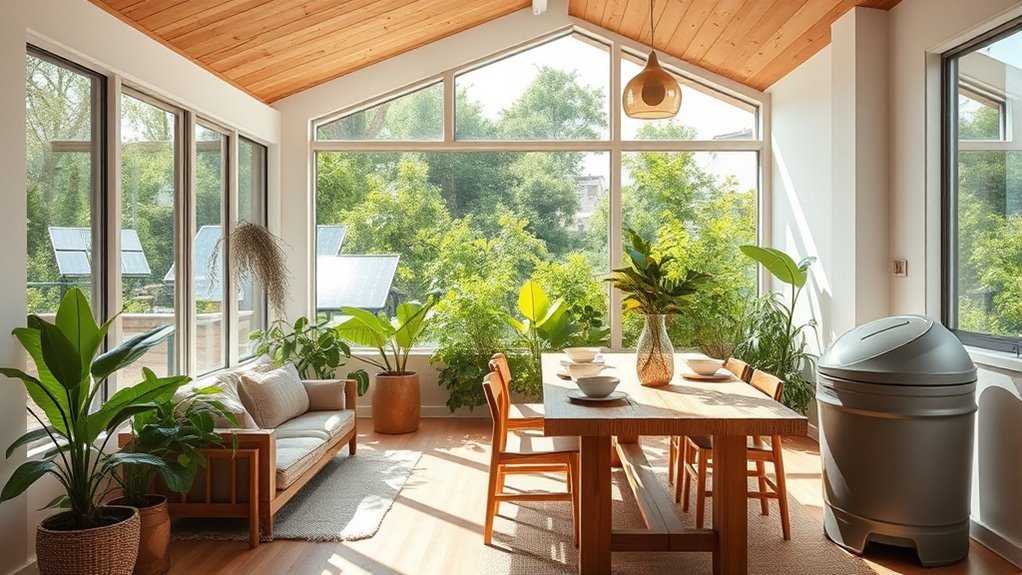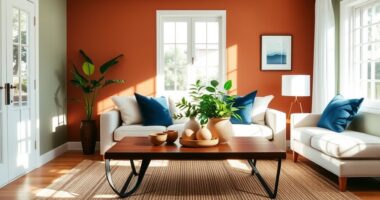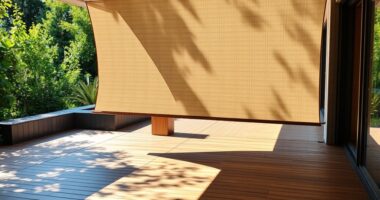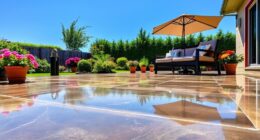If you want to embrace sustainable living, start with energy-efficient appliances and fixtures that cut utility costs. Consider installing solar panels to lower your carbon footprint and save money long-term. Opt for eco-friendly building materials like reclaimed wood and low-VOC paints to enhance your home’s appeal. Don’t forget water conservation strategies, such as rainwater harvesting and drought-tolerant landscaping. Finally, add indoor plants to purify your air and boost your well-being. Discover more ways to make your home eco-friendly!
Key Takeaways
- Upgrade to energy-efficient appliances and LED lighting to significantly reduce energy consumption and utility bills.
- Invest in solar panels for renewable energy, potentially achieving net zero energy bills and increasing your home’s value.
- Use eco-friendly building materials like reclaimed wood and recycled glass to lower your carbon footprint and enhance durability.
- Implement water conservation strategies, such as rainwater harvesting and drought-tolerant landscaping, to minimize water usage and utility costs.
- Incorporate indoor plants to improve air quality, enhance humidity levels, and create a healthier living environment.
Energy-Efficient Appliances and Fixtures
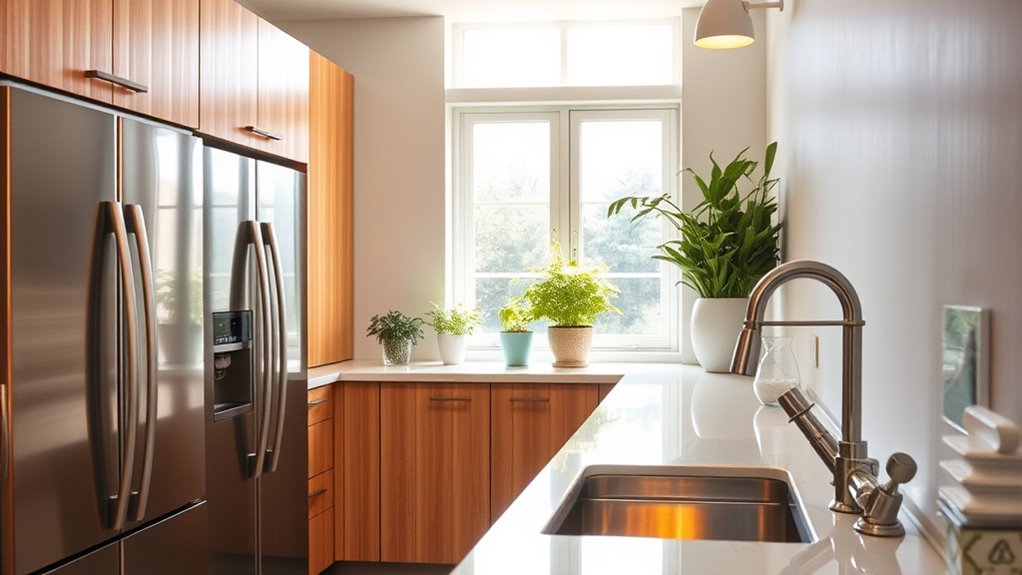
When you upgrade to energy-efficient appliances and fixtures, you not only cut down on your utility bills but also contribute to a more sustainable future.
By choosing ENERGY STAR-certified appliances, you can reduce energy consumption by 10-50%, leading to significant savings.
Replacing incandescent bulbs with LED lighting decreases electricity usage by up to 90%, and these bulbs last about 25 times longer.
Installing low-flow fixtures, like showerheads and faucets, can cut water usage by 20-60% while maintaining performance, promoting water conservation.
Plus, integrating smart home technology, such as energy monitors and smart thermostats, optimizes energy use by automatically adjusting settings based on occupancy.
Additionally, investing in air purifiers with HEPA filters can improve indoor air quality, contributing to a healthier living environment.
All these upgrades not only save you money but also enhance your home’s market value.
Solar Panels and Renewable Energy Systems
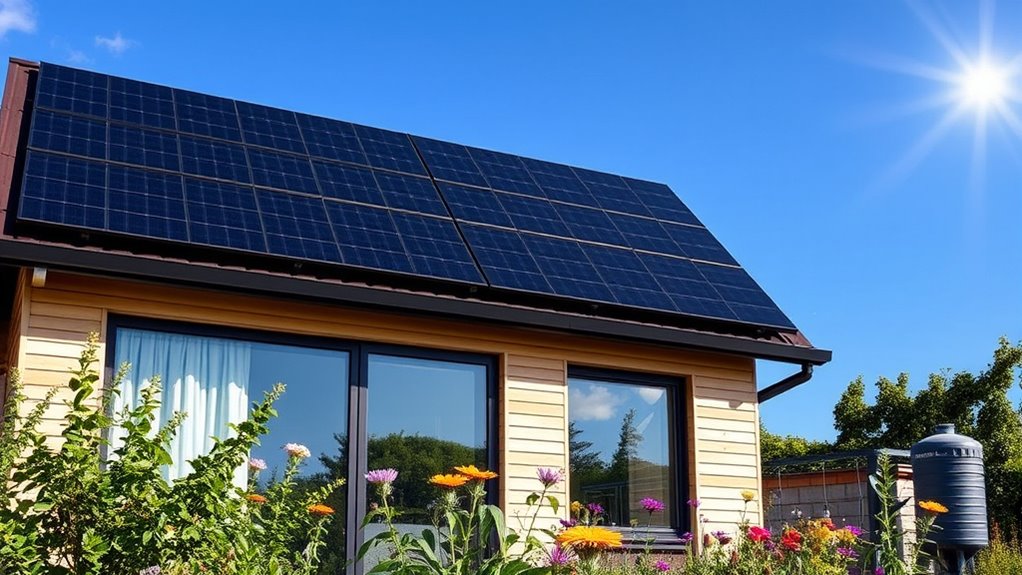
If you’re looking to embrace sustainable living, solar panels can be a game changer for your home.
Not only do they help you save money in the long run, but they also boost your property value.
Plus, with various installation options available, you can find a solution that perfectly fits your space.
Benefits of Solar Energy
As you explore sustainable living options, the benefits of solar energy become increasingly clear. By investing in solar panels, you can greatly reduce reliance on fossil fuels, leading to a lower carbon footprint and contributing to a cleaner environment.
Not only do solar systems help in cutting down monthly energy costs, but they also lead to potential net zero energy bills. Over 25 years, homeowners typically save around $50,000, making solar energy a financially sound investment.
Plus, many states offer tax incentives and rebates, making the initial cost even more manageable. Homes with solar energy systems often sell for four percent more than those without, reflecting the growing preference for renewable energy solutions in today’s market. Additionally, integrating solar charge controllers can optimize energy harvest, further enhancing system efficiency and performance.
Installation Options Explained
Understanding your installation options is essential for maximizing the benefits of solar energy systems. You can choose to install solar panels on your rooftop or in your yard, depending on your property layout and sunlight access. This flexibility allows you to incorporate renewable energy seamlessly into your home’s design.
The average installation costs have decreased considerably, making solar energy more accessible. With tax incentives and rebates, you can cover a substantial portion of these costs. By investing in solar panels, you not only reduce energy costs but also enhance your home’s eco-friendly features.
Over time, the long-term savings can add up, potentially saving you around $50,000 over 25 years and increasing your property value by 4%. Additionally, incorporating energy-efficient systems like heat pumps can further enhance your home’s sustainability while reducing overall energy consumption.
Eco-Friendly Building Materials
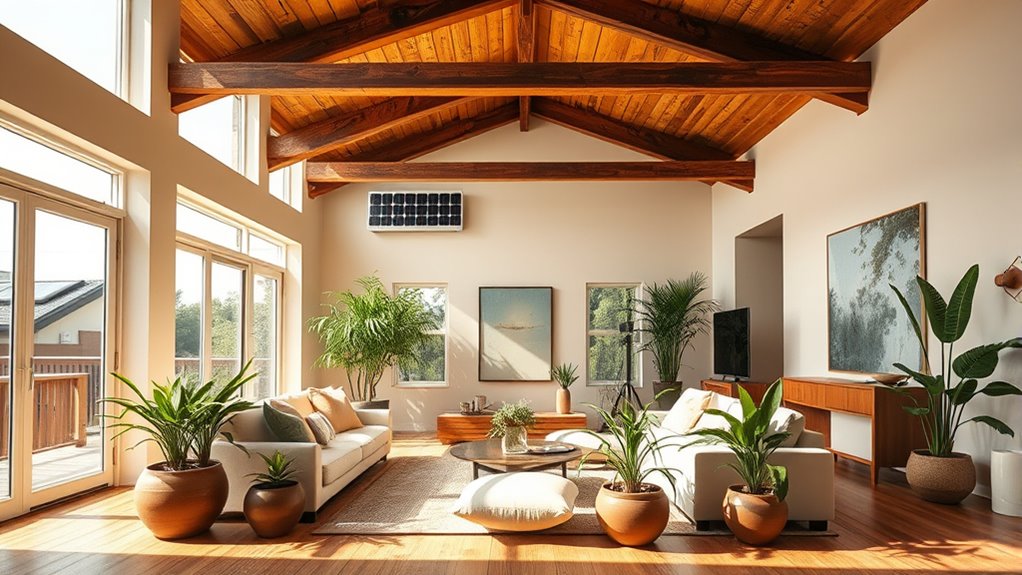
When you’re considering building or renovating, eco-friendly materials like reclaimed wood and bamboo can make a big difference. These sustainable options not only enhance the durability of your structure but also boost its aesthetic appeal. Additionally, exploring sustainable building materials can lead to innovative designs that maximize space efficiency, as seen in various tiny house projects.
Reclaimed and Sustainable Options
While many people seek stylish and modern homes, incorporating reclaimed and sustainable building materials can enhance both aesthetics and environmental responsibility.
Reclaimed wood and bamboo are standout options, as bamboo captures 5-6 times more CO2 than softwoods and regenerates rapidly.
You can also consider eco-friendly building materials like recycled glass countertops and low-VOC paints, which add beauty while reducing your carbon footprint.
Sustainable materials such as cork and reclaimed metal are increasingly popular for their lower environmental impact compared to traditional choices.
By selecting renewable and biodegradable options, like wool insulation and eucalyptus, you not only improve the quality of your home but also promote sustainable construction practices.
Embracing these materials reflects a commitment to a greener future. Additionally, utilizing efficient storage strategies can further enhance your eco-friendly home by reducing clutter and maximizing space efficiency.
Benefits of Durable Materials
Choosing durable, eco-friendly building materials not only benefits the environment but also guarantees that your home stands the test of time.
By opting for sustainable building materials like bamboo and reclaimed wood, you considerably reduce environmental impact while ensuring durability that outlasts traditional options.
Materials with recycled content, such as recycled glass countertops and low-VOC paints, help lower your carbon footprint and promote responsible sourcing.
Investing in these eco-friendly materials leads to higher quality structures, ultimately minimizing maintenance costs and the need for replacements.
Plus, you’ll contribute to less deforestation and pollution during construction, making a positive difference for the planet.
Embracing durability and sustainability now means a more resilient home for years to come. Additionally, using properly seasoned wood in your wood stove can significantly enhance combustion efficiency and minimize harmful emissions.
Aesthetic Appeal and Functionality
Eco-friendly building materials not only serve a functional purpose but also elevate the aesthetic appeal of your home. By choosing sustainable materials like bamboo and reclaimed wood, you add unique character that stands out.
Durable options, such as recycled glass countertops and low-VOC paints, create stylish interiors while minimizing harmful emissions, promoting healthier living spaces. These eco-friendly materials enhance the longevity of home structures, reducing the need for frequent repairs.
Additionally, incorporating ethically-sourced materials supports responsible practices that preserve natural resources for future generations. Homes built with these sustainable materials often attract eco-conscious buyers, boosting your market value in a competitive real estate environment. Furthermore, using sustainable materials can significantly reduce your home’s carbon footprint.
Embracing eco-friendly options can transform your living space and benefit the planet.
Water Conservation Strategies

As you explore ways to conserve water, you’ll find that implementing effective strategies not only benefits the environment but also lowers your utility bills.
Consider installing rainwater harvesting systems to capture and store rainwater for irrigation, greatly cutting down municipal consumption. Graywater recycling systems can also help, allowing you to repurpose water from sinks and showers for your garden, reducing potable water usage by up to 50%.
Implement rainwater harvesting and graywater recycling to significantly reduce water consumption and promote sustainable gardening practices.
Opt for drought-tolerant landscaping with native plants that require less water, minimizing irrigation needs. Additionally, smart irrigation systems equipped with sensors optimize watering schedules based on weather conditions, promoting efficient water use. Regular maintenance can extend the life of pop-up camper canvas, ensuring it’s ready for outdoor adventures while conserving water resources.
Embracing these water conservation strategies supports sustainable water management practices and helps preserve local water resources.
Passive Design Principles
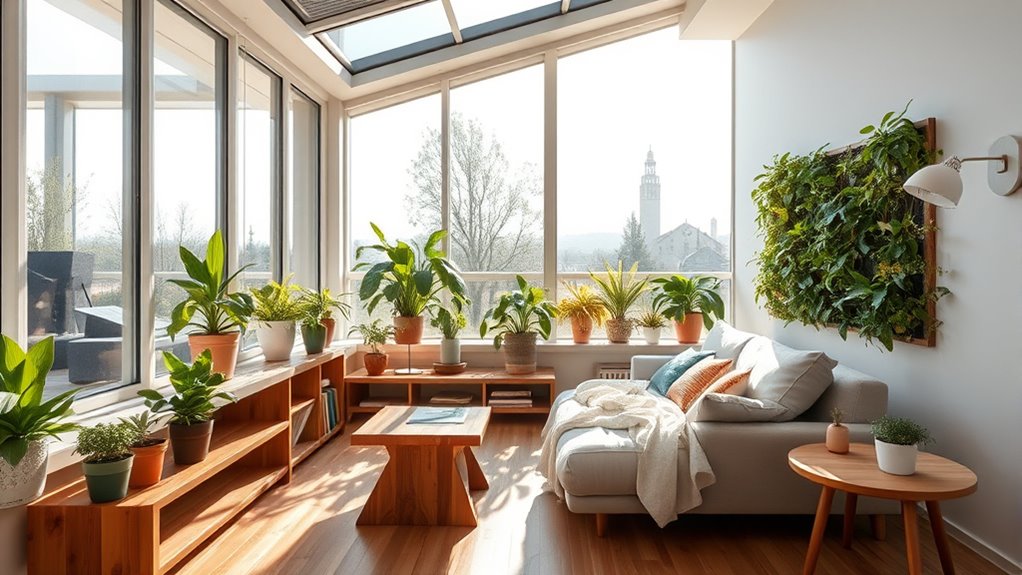
Implementing water conservation strategies lays the groundwork for broader sustainable living practices, including the integration of passive design principles in your home.
By maximizing natural light through large windows and skylights, you can reduce your reliance on artificial lighting and enhance indoor comfort. Incorporating thermal mass materials like concrete or stone helps regulate indoor temperatures, which can greatly reduce energy consumption for heating and cooling.
Additionally, utilizing natural ventilation techniques promotes airflow, lowering the need for mechanical cooling systems. The orientation of your home can also optimize solar gain in winter while minimizing heat absorption in summer, achieving a balanced indoor climate year-round. Embracing these passive design principles leads to energy-efficient homes that can cut energy consumption by up to 50%. Moreover, integrating heat pump technology enhances your home’s energy efficiency further by providing both heating and cooling capabilities.
Smart Home Technology
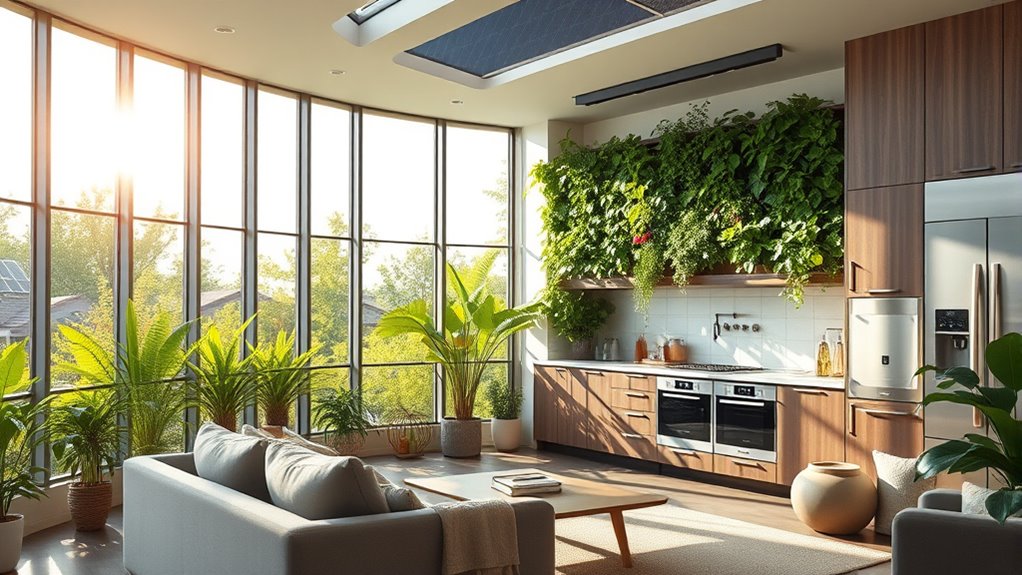
Smart home technology can transform how you manage energy in your home.
With automated climate control and energy monitoring systems, you can optimize usage and cut down on waste.
You’ll enjoy greater comfort while also saving money on your utility bills. Additionally, integrating heat pump technology into your smart home system can further enhance energy efficiency and sustainability.
Energy Monitoring Systems
How can energy monitoring systems transform your home into a more efficient space? These smart devices track real-time energy consumption, helping you identify waste and make informed decisions.
By understanding which appliances consume the most energy, you can target upgrades or adjustments to reduce energy consumption and boost sustainability.
- Cut down your utility bills considerably
- Receive alerts for unusual energy spikes
- Integrate with other smart home technology
- Achieve up to 15% energy savings
With energy monitoring systems, you’ll enjoy cost savings while living sustainably.
You’ll be empowered to make changes that not only benefit your wallet but also the environment. Embrace smart home technology to enhance your living space and contribute to a greener future.
Automated Climate Control
Automated climate control systems can revolutionize the way you manage your home’s temperature, making it more comfortable and energy-efficient. By utilizing smart HVAC systems, you can reduce heating and cooling costs by up to 10-15%. These systems learn your habits, optimizing performance to minimize energy usage. Integration with energy monitors provides real-time data, helping you identify waste and enhance energy efficiency. Some advanced systems even sync with weather forecasts, adjusting settings proactively. This technology not only improves comfort but also considerably contributes to achieving Zero Net Energy (ZNE) goals.
| Feature | Benefit | Outcome |
|---|---|---|
| Smart Thermostats | Adjusts based on occupancy | Reduces energy costs |
| Energy Monitoring | Real-time data on usage | Identifies waste |
| Learning Algorithms | Optimizes HVAC performance | Increases comfort |
| Weather Sync | Proactive adjustments | Enhances efficiency |
| ZNE Contribution | Minimizes carbon footprint | Sustainable living |
Indoor Plants for Air Quality
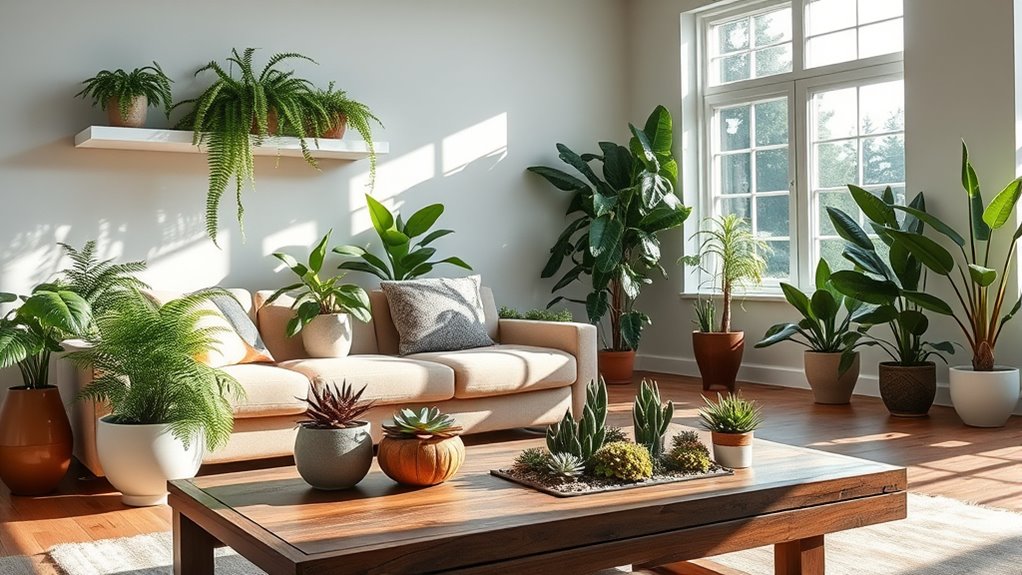
Indoor plants, like spider plants and peace lilies, play an essential role in enhancing air quality in your home.
These green companions can naturally filter toxins, improving overall air quality and creating a healthier living environment. Research shows that certain houseplants can remove up to 87% of indoor air pollutants in just 24 hours.
Indoor plants can effectively filter toxins and enhance air quality, contributing to a healthier living space.
Incorporating indoor plants can also boost humidity levels, alleviating respiratory issues and dry skin.
Consider these benefits of adding indoor plants to your sustainable home:
- Filter harmful toxins like formaldehyde and benzene
- Improve air quality and promote health
- Increase humidity for comfort
- Boost productivity and reduce stress
Sustainable Flooring
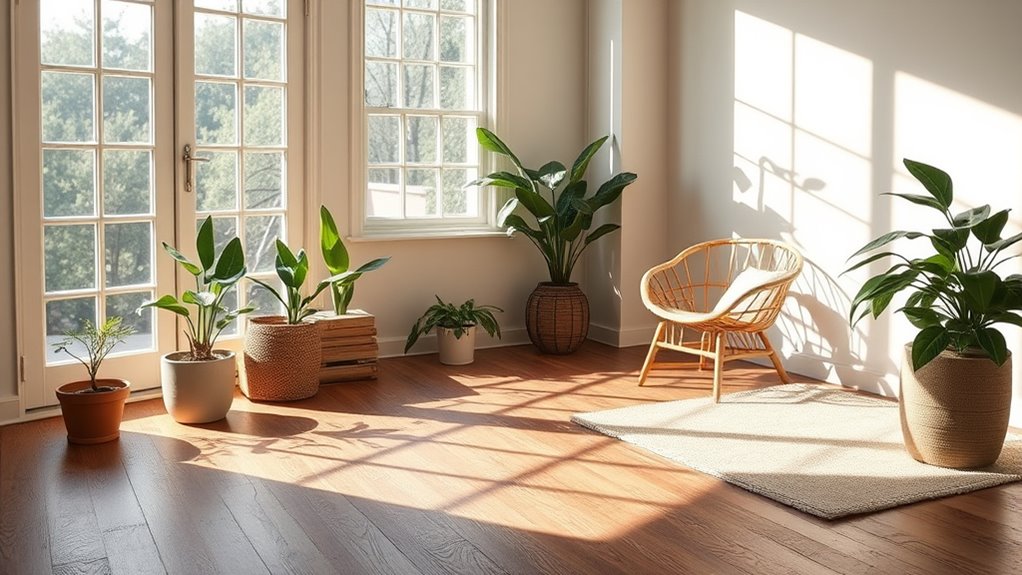
When you consider the impact of your flooring choices, opting for sustainable materials can greatly reduce your home’s environmental footprint.
Sustainable flooring options like bamboo, cork, and reclaimed wood offer environmentally friendly alternatives. Bamboo, a fast-growing grass, captures more CO2 than traditional hardwoods and can be harvested every 3-5 years, making it a renewable resource.
Similarly, cork is harvested from the bark of cork oak trees, allowing them to regenerate while sequestering carbon, contributing to lower carbon footprints.
Reclaimed wood, on the other hand, repurposes timber from old buildings, minimizing waste and avoiding the environmental impact of new lumber production.
Choosing these sustainable flooring materials not only benefits the planet but also enhances the unique character of your home.
Composting Systems

Choosing sustainable flooring is just one way to enhance your home’s eco-friendly profile.
Another impactful method is by implementing composting systems. You can substantially reduce landfill waste by recycling food scraps and organic materials, diverting about 30% of your total waste.
Consider these options to get started:
- Small compost bins for kitchens or backyards
- Curbside composting services in urban areas
- Compost tumblers for faster decomposition
- Bokashi systems for indoor composting
Eco-Friendly Paints

If you care about creating a healthier living space, eco-friendly paints are a smart choice for your home. Formulated with natural ingredients and low VOC levels, these paints enhance indoor air quality while reducing harmful emissions found in traditional options. You’ll find a variety of colors and finishes that allow you to decorate stylishly without sacrificing safety. Plus, many eco-friendly paints are durable, offering excellent coverage and requiring fewer coats, which minimizes waste. By opting for eco-friendly paints, you’ll not only improve your home’s atmosphere but also support sustainable home improvement practices and lower your overall environmental impact.
| Feature | Eco-Friendly Paints |
|---|---|
| Ingredients | Natural |
| VOC Levels | Low or Zero |
| Indoor Air Quality | Improved |
| Coverage | Excellent |
| Environmental Impact | Reduced |
Frequently Asked Questions
What Is the Most Eco-Friendly Type of House?
The most eco-friendly type of house is a Zero Net Energy (ZNE) home. It produces as much renewable energy as it consumes, often through solar panels and energy-efficient designs.
By choosing sustainable materials like bamboo or reclaimed wood, you greatly reduce your carbon footprint.
Plus, implementing passive design principles can enhance natural heating and cooling, minimizing reliance on HVAC systems.
What Are the Statistics for Eco-Friendly Trends?
You might feel a sense of hope when you see the numbers behind eco-friendly trends.
Homes with solar panels save you an impressive $50,000 over 25 years and boost property value by four percent.
Energy-efficient appliances, like ENERGY STAR-rated products, cut energy use by up to 50%, while new homes increasingly incorporate sustainable materials.
With water-saving strategies, you can slash water usage by half, proving that small changes can lead to significant savings and environmental benefits.
What Is Sustainable Living and Eco-Friendly Lifestyle?
Sustainable living means making choices that reduce your environmental impact. You focus on mindful consumption, conserve resources, and manage waste effectively.
An eco-friendly lifestyle often includes using renewable energy sources, choosing sustainable materials, and investing in energy-efficient appliances.
By adopting these practices, you not only help the planet but also can save money on utility bills over time.
Embracing this lifestyle means you’re part of a growing movement toward a healthier future.
What Makes an Eco-Friendly Home?
You know what they say, “an ounce of prevention is worth a pound of cure.”
An eco-friendly home combines energy efficiency with sustainable materials to create a healthier living space. You’ll find Energy Star appliances and LED lighting reducing energy use considerably.
Incorporating low-flow fixtures helps conserve water, while smart technology optimizes your energy consumption.
With thoughtful design, you can maintain comfort naturally, cutting down on utility bills and reducing your environmental impact.
Conclusion
By embracing these eco-friendly home trends, you’re not just enhancing your living space; you’re also contributing to a healthier planet. Did you know that homes using energy-efficient appliances can reduce energy consumption by up to 30%? Imagine the savings and the positive impact on the environment! So, whether it’s installing solar panels or opting for sustainable materials, every small choice you make adds up to a big difference. Let’s create a greener future together!
